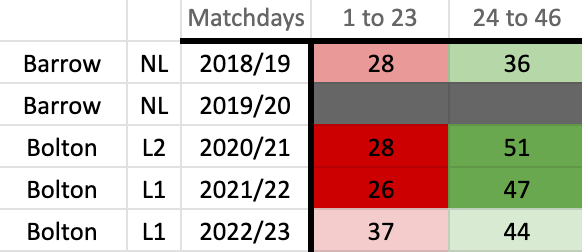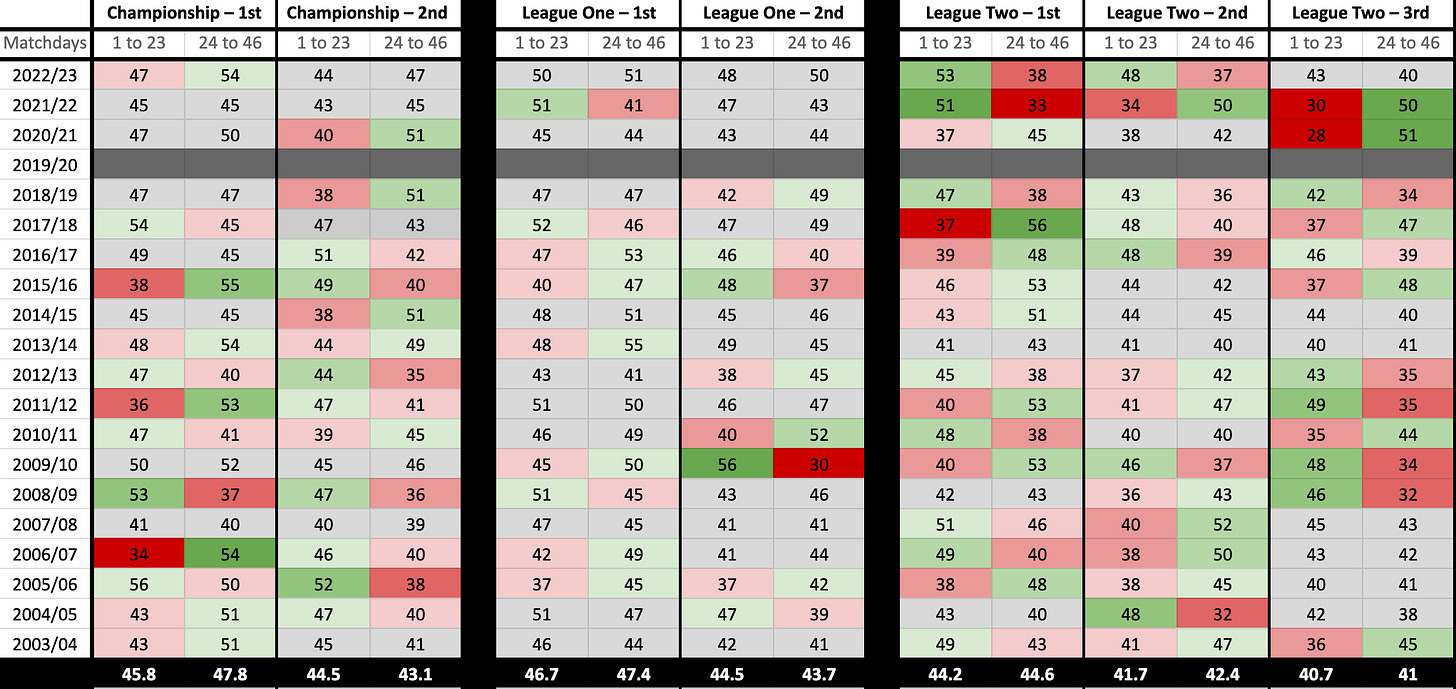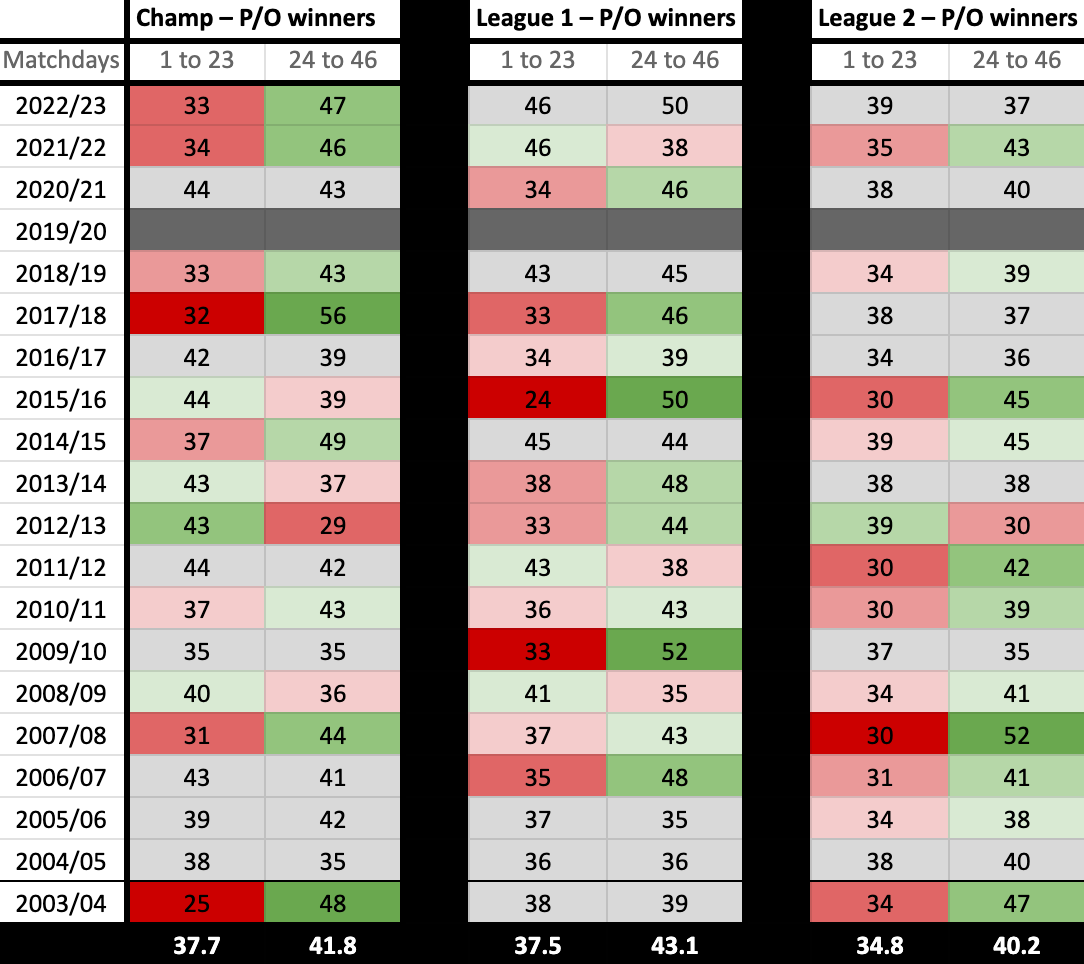Happy Halfway Day! Who's getting promoted?
Flying Foxes, good news for Bolton fans – and a warning for our league leaders...
Huw Davies
It’s really no surprise that Jon Bon Jovi was living on a prayer. Given how much of a big deal he was making about being only halfway there, he would’ve been knackered by the time he arrived. But I share his excitement about reaching that milestone, because we’re officially 50%* of the way through the EFL season, and so I’m giving you a present – no, no, I insist – to read en route to your club’s Boxing Day fixture: how Halfway Day can predict promotion.
*The Championship season is 50% done, anyway – Leagues One and Two are on 47% and 48% due to postponements caused by bad weather, international call-ups and sheer bloody laziness.
I love Halfway Day, and hate that the English league football schedule gives us a few days at most to take stock of Act One before Act Two begins. No interval, no pricy ice cream – we’re straight into Matchday 24 of 46 in the Championship, with the rest of the Football League not far behind, and by the end of the Christmas period we’ll be talking about run-ins. Things can and do change very, very quickly.
So, let’s take a moment to consider the campaign’s mid-point, and what the past can teach the present about this season’s future. I’ve looked at Acts One and Two of every promoted team from the past 20 years (excluding 2019/20), as well as some who couldn’t last the pace. Colossal collapses, preposterous promotions, trends, patterns, predictions and punts – it’s all here, with some laboured jokes thrown in.
And if it’s desperate hope you’re after, remember: there was a team sat in League One’s relegation zone on this day eight years ago who ended up winning promotion that season…
Foxes win Royals hunt
First, the good news. Yes, Leicester, you’re the bestest. You’ve broken 2005/06 Reading’s half-season record and have a good chance to break the fabled 106-point barrier, too, given the Royals dropped off as if it was 18th-century France. Only 50 points from 23 matches, having taken 56 from the first 23? Pathetic.
Teams that start like a train can finish like a traction engine. Each of League Two’s last two title-winners slowed to a crawl: Leyton Orient last year, having posted the fourth tier’s best pre-Christmas campaign since records began (specifically my records, so 2003/04), and Forest Green Rovers in 2021/22. They had 150% of Exeter’s points tally at the halfway mark, 51 to 34, yet required goal difference and an Exeter defeat to nick the title from them on final day. FGR were champions despite effectively being a mid-table side from January onwards. And they say vegans tire easily.
That’s the importance of racing out of the blocks. Wolves’ Championship champions of 2008/09 made the club’s best start for nearly half a century, and bookended it with a strong finish, but had to endure the nightmare after Christmas with just one win between Yuletide and St David’s Day (it’s March 1st, you heathens). They emerged from that period still top of the table, such was the lead they’d built.
With Darren Moore gone, Doncaster fell from 1st to 14th in the second half of the League One season, taking 16 points from 23 matches
Besides, there’s always the second or even third automatic promotion spot to fall back on. Rochdale were thankful for League Two’s bronze-olation prize in 2009/10, when they kept an impressive pace right up to the end of March before stopping at the finish line to scratch their arse and do the crossword. Holding a 10-point lead over 2nd, Dale then went LDLLWLLLL in April and May with a -11 goal difference, limping to 3rd and a very sheepish podium place. In League One that season, Leeds were 11 points ahead of Norwich at halfway and finished nine points behind them. They did at least secure promotion; Marcelo Bielsa’s side wouldn’t get away with being leapfrogged by Norwich nine years later, going on to lose in the play-offs.
The other sides mentioned still went up, though, and that’s all that matters. Of the 60 teams to top their tier’s 23-game table over the last 20 completed Football League campaigns, 47 – more than three-quarters – have won automatic promotion. Only two didn’t even reach the play-offs. And the prominence of this dominance is increasing, especially in the Championship, thanks to ever-wealthier clubs parachuting down from the Premier League’s diamond-encrusted airship. As many as 10 of the second tier’s last 14 Halfway Day champions finished as real champions as well, and two of the other four came 2nd.
But enough about dominant winners – we want to see who crashed from a great height. That’s the only reason anybody watches bobsledding, after all. So, 47 out of 60 half-time leaders finished 1st or 2nd; what about the unlucky 13?
Two of them collapsed in the same season, and collapsed so comprehensively that I’m again forced to wonder if 2020/21’s behind-closed-doors campaign was just a fever dream. If a title challenge falls in an empty stadium… anyway, the history books claim that Chris Beech’s Beech-ball Carlisle finished 10th in League Two despite picking up more points than anyone else through the first 23 fixtures, and that Doncaster, having had Darren Moore poached by Sheffield Wednesday, dropped from 1st to 14th in League One by taking 16 points from 23 matches. Both suffered from COVID-related fixture backlog.
That’s two of our tumbling table-toppers accounted for. As for the other 11… prepare yourself for an incredible statistic.
Momentum in the play-offs is real (part 1)
Did you prepare yourself? Good. Because in the past two decades, no team has won promotion after dropping into the play-offs from 1st in mid-season. None. And that’s 11 teams, each theoretically among the play-off favourites. Even more remarkably, and I will be getting the italics out as well here, nine half-time leaders in the Championship and League One have fallen into the play-off places and every single one has lost their semi-final.
We’re through the looking glass here, people. Momentum matters, even more than we thought.
OK, Davies, slow down. Let’s be sure about this before making wild claims. Were these nine teams really on such a downward curve going into post-season that they couldn’t even get to Wembley/Cardiff?
It’d be harsh to say that about several League One ‘failures’. Walsall (2015/16) and Scunthorpe (2016/17) did well even to finish 3rd, and each entered their semi-final in good form. Portsmouth finished 4th in 2018/19 with 88 points, which is a good tally whichever way you slice it, and lost very narrowly to Sunderland. Nottingham Forest, in 2006/07, had already recovered from a tricky winter and did win the first leg of their semi-final 2-0, only to inexplicably lose 5-2 in extra time at home to Yeovil. We could blame negative momentum in the match, or simply the red card for David ‘Prutts’ Prutton, but not negative momentum in the regular season. As for Brentford a year earlier, they were beaten in a battle of narrative by Swansea, another team who’d fallen from a mid-season summit, and they couldn’t both lose.
If any of Leicester, Portsmouth or Stockport slip into the play-offs, then there they will perish
Sheffield United, however, were a picture of post-peak malaise in 2012-13’s run-in. They’d bounced back from shootout despair at Wembley to go unbeaten through to mid-November – and sure, in hindsight, maybe drawing half of their fixtures and averaging 1.19 goals per game wasn’t ‘automatic promotion’ material, but they found their shooting boots and a Boxing Day victory put the Blades top, touching two points per game. Then a couple of brief wobbles prompted the board to sack Danny Wilson with just five fixtures remaining and automatic promotion still within their grasp, a decision described by the Daily Mail at the time as “a major gamble” and by The Pinch’s Sam Parry just now as “absolutely fucking brainless”. Led by caretaker Chris Morgan, United limped home in 5th before losing to Yeovil (them again).
There are similar tales of woe among the Championship’s unofficial apertura winners. Leeds, 2018/19: Spygate, deliberately giving an opponent a free goal, 10 defeats in half a season and one point taken from the final four fixtures – it’s a tale as old as time. Derby, 2015/16: Paul Clement sacked in February with County 5th and interim Andy Wassall unable to take them higher. Before them, Watford in 2007/08: a great start undone by Adam Johnson’s loan recall and Marlon King’s sale in January. They finished 6th, reaching the play-offs on goal difference alone and on the back of 1 (one!) win in 14 (fourteen!) games. Naturally, they lost 6-1 on aggregate to Hull. There’s that ‘momentum’ word again.
Is it a curse? Were the foundations of these foundering title challenges built on an Indian burial ground? Or is this just an unfortunate mix of harsh sackings, fixture congestion and reversion to the mean? Either way, throw in League Two’s pair of defeated play-off finalists as well – Grimsby in 2005/06 and Plymouth 10 years later – and the conclusion is obvious: if any of our 23-game league leaders slip into the play-offs, then there they will perish, and probably without a day out at Wembley to boot. Leicester should be fine, but Stockportsmouth: you have been warned.
Stand by your man
Champions are usually better in the second half of the season, even in League Two, despite the aforementioned pair of Orient and Forest Green doing their best impression of this end to a marathon. Why is that? Oh, you’re asking me.
A managerial change would be a natural first guess, and it worked for Sunderland in 2006/07. They lost their opening four matches before hiring Roy Keane, and were still 19th in mid-November and 11th on Halfway Day, but obliterated the opposition after that with some hefty spending. Winning the Championship title after taking 24 points from their first 19 games was the equivalent of Birmingham becoming champions this season.
In fact, standing by your manager reaps dividends. Teams click and catch fire, like a malfunctioning Christmas toy. In 2015/16, relegated Burnley stuck with Sean Dyche and having been 5th on Boxing Day, nine points off the top, they went unbeaten for the rest of the season, flying to 1st in February and staying there with a phenomenal run of form using the same players. John Coleman’s Accrington, 9th while digesting their turkey, were simply unbelievable in the second half of League Two’s 2017/18 campaign. Some January garnish helped (Callum Johnson, Jimmy Dunne on loan) but consistency was the key: seven players started at least 43 of their 46 league fixtures, which is just preposterous. Everyone knew their jobs.
There’s yet more supporting evidence if we include the other automatic promotion places. Bolton stuttered for much of 2020/21, as new manager Ian Evatt got to grips with expectations and publicly told a 20-year-old loanee goalkeeper to “man up”. At the halfway mark, they had League Two’s third-worst defensive record and were closer to relegation than a play-off place. But 28 points from 24 games preceded a whopping 51 from 22, once Evatt and his players had adapted to one another and the division.
Good news, Bolton fans: Evatt is actually the poster boy for late-season runs (or slow starts, if you prefer). Here’s how his points have been divided to date.
Even Barrow’s promotion in the curtailed 2019/20 National League season began with seven points from nine games. The next 28 brought 63. The man just needs time.
Moving on from managers, are January transfers important? That handsome man said they can be transformative. Bristol Rovers discovered as much two years ago, when Elliot Anderson arrived from Newcastle mid-season and proved himself far too good for League Two. With fellow January loanee James Connolly also improving the Gas, they turned 23 points from 20 matches – barely a point per game – into 57 from 26, at more than 2ppg. Of course, they’d given their rivals such a headstart that they’d still need a 7-0 win on final day to clinch automatic promotion, and there’s no way THAT could happen.
How about standing by your manager and having a good January transfer window? That’d be 2017/18’s Championship play-off winners, Fulham, who stuck with a struggling Slavisa Jokanovic (unlike Sheffield United four years later, albeit with more justification) and were rewarded for it. Mid-table at halfway, they went on a ridiculous, record-breaking run of 59 points from 23 games. Jokanovic was one reason why, but loaning in Matt Targett and Aleksandar Mitrovic didn’t hurt, with Target allowing Ryan Sessegnon to play further forward while Mitrovic scored 12 goals in 14 games before Fulham went up through the play-offs.
And that leads us to our biggest discovery…
Play-off momentum is real (part 2)
In truth, the average difference between early and late points returns is pretty negligible for automatically promoted teams; things balance out, as you’d expect across 20 years of football, and the cream rises to the crop one way or another.
Fairly even, especially in League One. But wait. What about the reds and greens of the play-off winners?
By Jove, Holmes, there’s a pattern. Putting aside the temptation to use those averages as a formula and say that this season’s points tallies mean either West Bromwich or Hull will definitely be promoted at Wembley (sorry, Saints, it’s just maths), you can see a theme that tracks consistently across two decades: play-off winners tend to trend upwards as the season progresses, rather than starting fast. Again: momentum matters.
There’s no shortage of examples. Championship, 2003/04: Iain Dowie takes over with Crystal Palace in a relegation battle on 28 points from 24 games and, boosted by a Golden Boot-winning effort from Andy Johnson, they snatch a place in the play-offs and win them. League Two, 2007/08: Stockport soar from the bottom half on Halfway Day to 4th place and a 3-2 Wembley win over Rochdale. 2009/10, League One: Kenny Jackett’s slow-starting Millwall suddenly remember they’re good and boss the league from January onwards. Wimbledon in 2015/16, Nottingham Forest in 2021/22, Luton in 2022/23… you get the picture.
Yet one side trumps the lot – and naturally, Streaky Lee Johnson is involved. Remember that team I mentioned at the start, promoted from League One after spending Boxing Day in the dropzone? That was Johnson’s Barnsley, on 21 points from 22 games thanks to eight consecutive league defeats in October and November. They actually had half as many points on Halfway Day as Walsall, the team they later beat 6-1 on aggregate in the play-off semi-finals.
Then Streaky Lee did a Streaky Lee and won six in a row, taking Barnsley into the top half… whereupon he left them for Bristol City, less than a year after rocking up at Oakwell. It was Paul Heckingbottom who did the rest. Might Johnson have finished the job anyway? Who cares? Barnsley give hope to us all.
So, perk up, QPR, Fleetwood and Forest Green! We could yet see you at Wembley in May. Now there’s a belated Christmas present for you.





